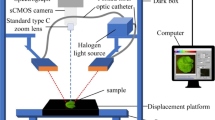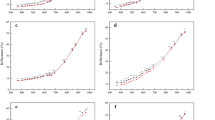Abstract
This study investigated the feasibility of hyperspectral imaging techniques to estimate the vigor of heat-damaged Quercus variabilis seeds. Four thermal damage grades were classified according to heat treatment duration (0, 2, 5, and 10 h). After obtaining hyperspectral images with a 370–1042 nm hyperspectral imager that included visible and near infrared light, germination was tested to confirm estimates. The Savitzky–Golay (SG) second derivative was used to preprocess the spectrum to reduce any noise impact. The successive projections algorithm (SPA), principal component analysis, and local linear embedding algorithm were used to extract the characteristic spectral bands related to seed vigor. Finally, a model for seed vigor classification of Q. variabilis based on partial least squares support vector machine (LS-SVM) with different spectral data sets was developed. The results show that the spectrum after SG second derivative preprocessing was better for developing the model, and SPA performed the best among the three feature band selection methods. The combination SG second derivative-LS-SVM provided the best classification model for Q. variabilis seed vigor, with the prediction set reaching 98.81%. This study provides an important basis for rapid and nondestructive assessment of the vigor of heat-damaged seeds using hyperspectral imaging techniques.








Similar content being viewed by others
References
Cheng JH, Jin HL, Liu ZW (2018) Developing a NIR multispectral imaging for prediction and visualization of peanut protein content using variable selection algorithms. Infrared Phys Technol 88:92–96
Diniz P, Pistonesi M, Alverez MB, Band BS, Araujo M (2015) Simplified tea classification based on a reduced chemical composition profile via successive projections algorithm linear discriminant analysis (SPA-LDA). J Food Compos Anal 39:103–110
Doherty B, Daveri A, Clementi C, Romani A, Bioletti S, Brunetti B, Sgamellotti A, Miliani C (2013) The Book of Kells: a non-invasive MOLAB investigation by complementary spectroscopic techniques. Spectrochim Acta A 115:330–336
Du MJ, Ding SF, Jia HJ (2016) Study on density peaks clustering based on k-nearest neighbors and principal component analysis. Knowl Based Syst 99:135–145
Dumont J, Nirvonen T, Heikkinen V, Mistretta M, Granlund L, Himanen K, Keinanen M (2015) Thermal and hyperspectral imaging for Norway spruce (Picea abies) seeds screening. Comput Electron Agric 116:118–124
Guama JG, Linera GW (2006) Edge effect on acorn removal and oak seedling survival in Mexican lower montane forest fragments. New Forest 31:487–495
Guo DS, Zhu QB, Huang M, Guo Y, Qin JW (2017) Model updating for the classification of different varieties of maize seeds from different years by hyperspectral imaging coupled with a pre-labeling method. Comput Electron Agric 142:1–8
Hui GY, Sun LJ, Wang JN, Wang LK, Dai CJ (2016) Research on the pre-processing pethods of wheat hardness prediction model based on visible-near infrared spectroscopy. Spectrosc Spectr Anal 36(7):2111–2116
ISTA (2019) International rules for seed testing. International Seed Testing Association 2019
Lanzano L, Li S, Costanzo E, Gulino M, Scordino A, Tudisco S, Musumeci F (2009) Time-resolved spectral measurements of delayed luminescence from a single soybean seed: effects of thermal damage and correlation with germination performance. Luminescence 24(6):409–415
Lee H, Kim MS, Qin JW, Park E, Song YR, Oh CS, Cho BK (2017) Raman hyperspectral imaging for detection of watermelon seeds infected with Acidovorax citrulli. Sensors 17(10):2188–2198
Li XL, Wei YZ, Xu J, Feng XP, Xu FY, Zhou RQ, He Y (2018a) SSC and pH for sweet assessment and maturity classification of harvested cherry fruit based on NIR hyperspectral imaging technology. Postharvest Biol Technol 143:112–118
Li Z, Li C, Gao Y, Ma WG, Zheng YY, Niu YZ, Hu J (2018b) Identification of oil, sugar and crude fiber during tobacco (Nicotiana tabacum L.) seed development based on near infrared spectroscopy. Biomass Bioenerg 111:39–45
Lombardi T, Fochetti T, Bertacchi A, Onnis A (1997) Germination requirements in a population of Typha latifolia. Aquat Bot 56(1):1–10
McIvor RT, Humphreys PK (2000) A case-based reasoning approach to the make or buy decision. Integr Manuf Syst 11(5):295–310
Metsalu T, Vilo J (2015) ClustVis: a web tool for visualizing clustering of multivariate data using Principal Component Analysis and heatmap. Nucl Acids Res 43:566–570
Mo C, Kim K, Lee K, Kim MS, Cho BK, Lim J, Kang S (2014) Nondestructive quality evaluation of pepper (Capsicum annuum L.) seeds using LED-induced hyperspectral reflectance imaging. Sensors 14(4):7489–7504
Nansen C, Zhao G, Darkin N, Zhao C, Turner SR (2015) Using hyperspectral imaging to determine germination of native Australian plant seeds. J Photochem Photobiol, B 145:19–24
Peng YK, Zhao F, Li L, Xing YY, Fang XQ (2018) Discrimination of heat-damaged tomato seeds based on near infrared spectroscopy and PCA-SVM method. Trans Chin Soc Agric Eng 34(5):159–165
Polyansky O, Zobov F, Viti S, Tennyson J (1998) Water vapor line assignments in the nearinfrared. J Mol Spectrosc 189(2):291–300
Qiu GJ, Lü E, Lu HZ, Xu S, Zeng FG, Shui Q (2018) Single-Kernel FT-NIR spectroscopy for detecting supersweet corn (Zea mays L. Saccharata Sturt) seed viability with multivariate data analysis. Sensors 18(4):1010–1025
Ringsted T, Ramsay JS, Jespersen BM, Keiding SR, Engelsen SB (2017) Long wavelength near-infrared transmission spectroscopy of barley seeds using a supercontinuum laser: prediction of mixed-linkage betaglucan content. Anal Chim Acta 986:101–108
Rinnan A, Berg F, Engelsen SB (2009) Review of the most common pre-processing techniques for near-infrared spectra. Trac Trend Anal Chem 28(10):1201–1222
Roweis ST, Saul LK (2000) Nonlinear dimensionality reduction by locally linear embedding. Science 290(5500):2323–2326
Shetty N, Min TG, Gislum R, Olesen MH, Boelt B (2011) Optimal sample size for predicting viability of cabbage and radish seeds based on near infrared spectra of single seeds. J Near Infrared Spectrosc 19(6):451–462
Sun Y, Gu XZ, Sun K, Hu HJ, Xu M, Wang ZJ, Pan LQ (2017) Hyperspectral reflectance imaging combined with chemometrics and successive projections algorithm for chilling injury classification in peaches. LWT Food Sci Technol 75:557–564
Wakholi C, Kandpal LM, Lee H, Hyungjin B, Park E, Kim ME, Cho BK (2018) Rapid assessment of corn seed viability using short wave infrared line-scan hyperspectral imaging and chemometrics. Sens Actuators B Chem 255:498–507
Wang L, Sun DW, Pu HB, Zhu ZW (2016) Application of hyperspectral imaging to discriminate the variety of maize seeds. Food Anal Methods 9:225–234
Yamatera H, Gondon G, Fitzpatrick B (1964) Near-infrared spectral of water and aqueous solutions. J Mol Spectrosc 14(3):268–278
Yang S, Zhu QB, Huang M, Qin JW (2017) Hyperspectral image-based variety discrimination of maize seeds by using a multi-model strategy coupled with unsupervised joint skewness-based wavelength selection algorithm. Food Anal Methods 10(2):424–433
Yang XL, Hong HM, You ZH, Cheng F (2015) Spectral and image integrated analysis of hyperspectral data for waxy corn seed variety classification. Sensors 15(7):15578–15594
Zhang TT, Wei WS, Zhao B, Wang RR, Li ML, Yang LM, Wang JH, Sun Q (2018) A reliable methodology for determining seed viability by using hyperspectral data from two sides of wheat seeds. Sensors 18(3):813–825
Zhou JY, Lin J, He JF, Zhang WH (2010) Review and perspective on Quercus variabilis research. J Northwest For Univ 25(3):43–49
Acknowledgements
Project funding: The work was funded by the National Natural Science Foundation of China (Grant No. 31770769), the National Key Research and Development Program of China (No. 2017YFC0504403) and the Fundamental Research Funds for the Central Universities (No. 2015ZCQ-GX-03).
Author information
Authors and Affiliations
Corresponding author
Additional information
Publisher's Note
Springer Nature remains neutral with regard to jurisdictional claims in published maps and institutional affiliations.
Project funding: The work was funded by the National Natural Science Foundation of China (Grant No. 31770769), the National Key Research and Development Program of China (No. 2017YFC0504403) and the Fundamental Research Funds for the Central Universities (No. 2015ZCQ-GX-03).
The online version is available at http://www.springerlink.com.
Corresponding editor: Tao Xu.
Rights and permissions
About this article
Cite this article
Pang, L., Xiao, J., Ma, J. et al. Hyperspectral imaging technology to detect the vigor of thermal-damaged Quercus variabilis seeds. J. For. Res. 32, 461–469 (2021). https://doi.org/10.1007/s11676-020-01144-4
Received:
Accepted:
Published:
Issue Date:
DOI: https://doi.org/10.1007/s11676-020-01144-4




